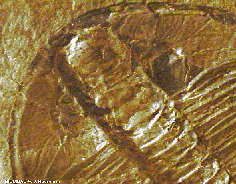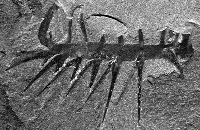| 1) Based on the principle of superposition, older fossils will be found beneath younger fossils. |
|
|
| | |
| 2) Evolution of new species through time results in: |
|
|
| | |
| 3) The stratigraphic principles of original horizontality, lateral continuity, and faunal succession allow geologists to correlate rocks throughout the world and build the geologic time scale. |
|
|
| | |
| 4) Which of the following is an example of co-evolution? |
|
|
| | |
| 5) Which of the following is an example of adaptive radiation? |
|
|
| | |
| 6) The history of life is an example of co-evolution with the earth because: |
|
|
| | |
| 7) When life formed, the earth's atmosphere was rich in O2. |
|
|
| | |
| 8) Abiotic synthesis of amino acids: |
|
|
| | |
| 9) What potential roll did clay minerals play in the origin of life? |
|
|
| | |
| 10) Protiens can be build abiotically from a solution of amino acids through: |
|
|
| | |
| 11) The origin of life is well documented in the fossil record. |
|
|
| | |
| 12) Bacterial photosynthesis was important in the Archean because: |
|
|
| | |
| 13) Oxygen levels in the atmosphere were probably low before 2.3 billion years ago because: |
|
|
| | |
| 14) Eukaryotes evolved after O2 levels were relatively high, because O2 is used in eukaryote biochemistry. |
|
|
| | |
| 15) Increasing oxygen levels in the Archean led to the evolution of less efficient biochemical pathways. |
|
|
| | |
| 16) Banded-iron formations are thought to result from: |
|
|
| | |

From: http://biodidac.bio.uottawa.ca/ |
| | |
| 17) The organism shown above is a: |
|
|
| | |
| 18) This animal group (shown in the photo above) is important in the evolution of life because: |
|
|
| | |
| 19) Which of the following has not been suggested as a cause of the Cambrian explosion of metazoan life: |
|
|
| | |

© University of Adelaide, used with permission of Tate Geological Museum |
| | |
| 20) The organism pictured above is a member of the Ediacaran fauna. |
|
|
| | |

From: http://www.nmnh.si.edu/paleo/pfoslidx.htm |
| | |
| 21) The organism pictured above is: |
|
|
| | |

From: http://www.lenet.fr/vegetal/banque/cormo-cooksonia.html |
| | |
| 22) In the illustration above, what are the structures at the tips of this plants branches? |
|
|
| | |
| 23) This plant fossil is important because: |
|
|
| | |
| 24) The land plants affected the worlds climate by: |
|
|
| | |
| 25) Airborne pollination and seeds were important to plants because: |
|
|
| | |
| 26) The evolution of land plants opened up new environments for animals to colonize. |
|
|
| | |
| 27) The climate in North America gradually cooled throughout the Mesozoic because of: |
|
|
| | |
| 28) Following the Permo-Triassic extinctions, the marine biosphere was dominated by: |
|
|
| | |
| 29) Diversity in the Marine Biosphere decreased throughout the Mesozoic. |
|
|
| | |
| 30) Terrestrial life in the Jurassic was dominated by dinosaurs and gymnosperms |
|
|
| | |
| 31) The sauropods were a group of dinosaurs that: |
|
|
| | |
| 32) What evidence do we have that hadrosaurs provided extensive parental care? |
|
|
| | |
| 33) Hadrosaurs appear to have been social animals, living in herds with other members of their species |
|
|
| | |
| 34) Which of the following was a member of the carnosaurs |
|
|
| | |
| 35) Why did some sauropods swallow rocks? |
|
|
| | |
| 36) The plates on the backs of stegosaurs were probably used to: |
|
|
| | |
| 37) The crests on some hadrosaurs were probably used to: |
|
|
| | |
| 38) Pterosaurs were a group of: |
|
|
| | |
| 39) The theropods were a group of dinosaurs that: |
|
|
| | |
| 40) Ornithischians were are group of: |
|
|
| | |
| 41) Birds evolved from ornithischians. |
|
|
| | |
| 42) Birds evolved from pterosaurs. |
|
|
| | |
| 43) In response to competition by thecodonts, therapsids (mammal-like reptiles) evolved: |
|
|
| | |
| 44) Mammalian traits, including warm-bloodedness, live birth, and parental care, may have evolved in response to living as small, nocturnal organisms. |
|
|
| | |
| 45) Birds evolved from dinosaurs during the Jurassic. |
|
|
| | |
| 46) In what geologic time period did mammals evolve from therapsids? |
|
|
| | |
| 47) Archaeopteryx is: |
|
|
| | |
| 48) Mosasaurs were: |
|
|
| | |
| 49) Which marine reptile group evolved in the Triassic and occupied a niche similar to modern walruses. |
|
|
| | |
| 50) Which mollusc group was an important reef forming organism in the Cretaceous |
|
|
| | |
| 51) Modern corals evolved during the Triassic |
|
|
| | |
| 52) Which of the following marine reptile groups became extinct before the Cretaceous-Tertiary extinctions. |
|
|
| | |
| 53) The marine reptiles in the Mesozoic occupied niches that would be later exploited by whales and dolphins. |
|
|
| | |
| 54) Early Mesozoic floras (plant communities) were dominated by: |
|
|
| | |
| 55) Flowering plants first appear in the Triassic |
|
|
| | |
| 56) Which of the following gave flowering plants a competitive advantage over gymnosperms in the Mesozoic? |
|
|
| | |
| 57) Why did flowering plants develop partnerships with small animals and not dinosaurs? |
|
|
| | |
| 58) Which of the following is not a benefit of animal-assisted fertilization: |
|
|
| | |
| 59) All land animals larger than 25 kg (55 lbs) went extinct at the end of the Cretaceous. |
|
|
| | |
| 60) What element that is common in asteroids is concentrated in the Cretaceous-Tertiary boundary sediments. |
|
|
| | |
| 61) The Cretaceous-Tertiary extinctions had minimal impact on Mesozoic marine communities. |
|
|
| | |
| 62) Which of the following groups were generally unaffected by the Cretaceous-Tertiary extinctions. |
|
|
| | |
| 63) Land plants and phytoplankton may have survived the Cretaceous-Tertiary extinctions as seeds and resting spores. |
|
|
| | |
| 64) Which of the following is not used as evidence for an asteroid impact at the Cretaceous-Tertiary boundary. |
|
|
| | |
| 65) The probable site of the asteroid impact is buried beneath Tertiary sediments on the Yucatan peninsula in Mexico |
|
|
| | |
| 66) Evolution of the grasses allowed: |
|
|
| | |
| 67) We have a much better understanding of evolution during the Cenozoic because: |
|
|
| | |
| 68) At the start of the Cenozoic, mammals underwent a major radiation |
|
|
| | |
| 69) The evolution of the horse provides an example of: |
|
|
| | |
| 70) Patterns of animal migrations during the Cenozoic can be related to plate tectonics and climatic changes |
|
|
| | |
| 71) The migration of man to North America appears to have had no effect on the existing large mammal faunas. |
|
|
| | |
| 72) Fossil evidence suggests that "Lucy" (Australopithicus afarensis) was bipedal |
|
|
| | |
| 73) Chimpanzee and Human lineages appear to have diverged |
|
|
| | |
| 74) What plate tectonic event led to the change from rain forest to savanna environments in Africa |
|
|
| | |
| 75) Homo erectus was probably the first hominid capable of advanced speech. |
|
|
|
|